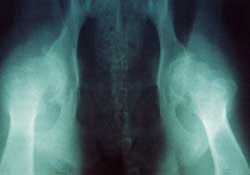|
HIP DYSPLASIA IN DOGS A GUIDE FOR DOG
OWNERS BY JOHN FOSTER
|
|
|
Hip Dysplasia in Dogs John Foster, BVSC, CertVOphthal,
MRCVS
|
| A look back to the modern dog's wolf-like ancestor
which roamed the plainsand forests millions of years ago shows
how critical it was to be able to movefreely and rapidly in
search of prey. Nature was quite uncompromising. If enough food
couldn't be caught or stolen due to an inability to run, jump,
twistand turn then starvation would be the only alternative.
When supper was provided by another this need for excellence
declined, so being a bit slower and being a bit stiff on a leg
didn't matter so much. The dog's association with man for more
than 10,000 years may appear to have been to mutual advantage
but some debts wait to be paid; one of these debts concerns
acondition called hip dysplasia. |
 |
| Hip dysplasia (HD) is a term which encompasses
a number of specfic developmental & other abnormalities
involving the hip joint. Developmental changes come first and
being related mainly to growth are known as primary changes.
Others come later; these are related to wear and tear from usage
and are termed secondary changes. The end result is that one
or pair of joints becomes mechanically unsound and therefore
does not function properly. An unsound joint is usually a painful
one and lameness will result. In extreme cases the dog may find
movement very difficult and much suffering will be involved.
It was in the light of these findings that the British Verterinary
Association (BVA) and the Kennel Club (KC) developed a scheme
over 30 years ago to assess the degree of hip malformation
of dogs through radiography. Over this time almost 100,000
radiogarphs (X-rays) have been examined to providde a standardised
opinion on HD status, principally for the use of breeders.
Currently 97 breeds are surveyed by the scheme in the UK.
|
| |
| STRUCTURE AND FUNCTION The
hip joints of land animals and even some birds are remarkably
similar. The design has with stood the test of time and usage
by countless species andis close to anatomic perfection. Where
mobility, meaning athieticism, is needed the normal hip is an
ideal way of enabling the transfer of power from the hind leg
muscles to the body so that the creature is driven forward with
strength and speed. The close relationship of the 'ball' to
the 'socket' permits rapid changes of direction and the strength
of the supporting structures ofligaments, tendons and muscles
makes the hip a unit. Large joint surfaces of cartilage lubricated
by joint fluid ensure smooth pain-free action. Little wonder,then,
that any disturbance to this ideal circumstance has such direconsequences. |
 |
| |
| |
|
|
|








